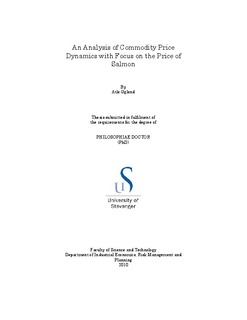| dc.contributor.author | Øglend, Atle | |
| dc.date.accessioned | 2010-08-10T14:42:45Z | |
| dc.date.available | 2010-08-10T14:42:45Z | |
| dc.date.issued | 2010-06-04 | |
| dc.identifier.citation | An analysis of commodity price dynamics with focus on the price of salmon by Atle Øglend, Stavanger : University of Stavanger, Faculty of Science and Technology, Department of Industrial Economics, Risk Management and Planning 2010 (PhD thesis UiS, no. 99) | en_US |
| dc.identifier.isbn | 978-82-7644-408-7 | |
| dc.identifier.issn | 1890-1387 | |
| dc.identifier.uri | http://hdl.handle.net/11250/182343 | |
| dc.description | PhD thesis in Industrial economics | en_US |
| dc.description | This thesis include one published article: | |
| dc.description | The Behaviour of Salmon Price Volatility by Atle Øglend and Marius Sikveland, In Marine Resource Economics (2008), Volume 23, pp. 507–526 (Marine Resource Economics is published by the MRE Foundation, Inc., P.O. Box 1828, Kingston, RI 02881 USA. All rights reserved) | |
| dc.description.abstract | This thesis is concerned with studying the short run dynamics of
commodity prices. The industry of interest and primary study is
Norwegian Aquaculture, with the price of farmed salmon as the
main data-set. Even though most of the cases studied are related to
the salmon market, it is my hope that some of the insights and
results can be applied to a more general set of agricultural or
conventional commodities.
This thesis falls in line with a large collection of research papers
and thesis’ on the Norwegian aquaculture industry. Motivated by
dissecting what has largely been a highly successful growth
industry, coupled with availability of detailed high quality data, a
great deal of economic research on the industry has been conducted.
Much of this research is related to long run supply side effects. A
large low frequency panel data set has laid the ground for
successful economic research into amongst other productivity
effects in the industry. Due to a lack of high frequency data, the
short run effects have been less studied. The only reliable high
frequency data available is price data. This thesis contributes to the
body of research on the industry by focusing on the short run price
dynamics of the commodity. In addition to studying short run
effects, the thesis introduces tools originally used in finance to
study the price data. Incorporating both traditional economic
analysis and finance is relevant when doing short run price
analysis, and provides an alternative angle for looking at the
commodity market.
Due to the lack of detailed high frequency data on state variables
other than price, the thesis applies non-structural time series
analysis as the method for empirical analysis. This necessarily
restricts direct inference of causality relationships. However, nonstructural
time series analysis provides a large battery of models to
reliably and thoroughly describe the dynamics of the series studied.
The detailed output from time series models are used in
combination with knowledge of predictable relative changes in
underlying state variables to understand the market dynamics. | en_US |
| dc.language.iso | eng | en_US |
| dc.publisher | University of Stavanger, Norway | en_US |
| dc.relation.ispartofseries | PhD thesis UiS; 99 | |
| dc.relation.uri | http://mre.cels.uri.edu/docs/08-Oglend.pdf | |
| dc.title | An analysis of commodity price dynamics with focus on the price of salmon | en_US |
| dc.type | Doctoral thesis | en_US |
| dc.subject.nsi | VDP::Social science: 200::Economics: 210::Economics: 212 | en_US |
